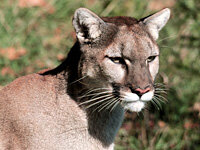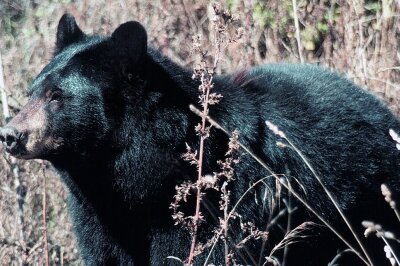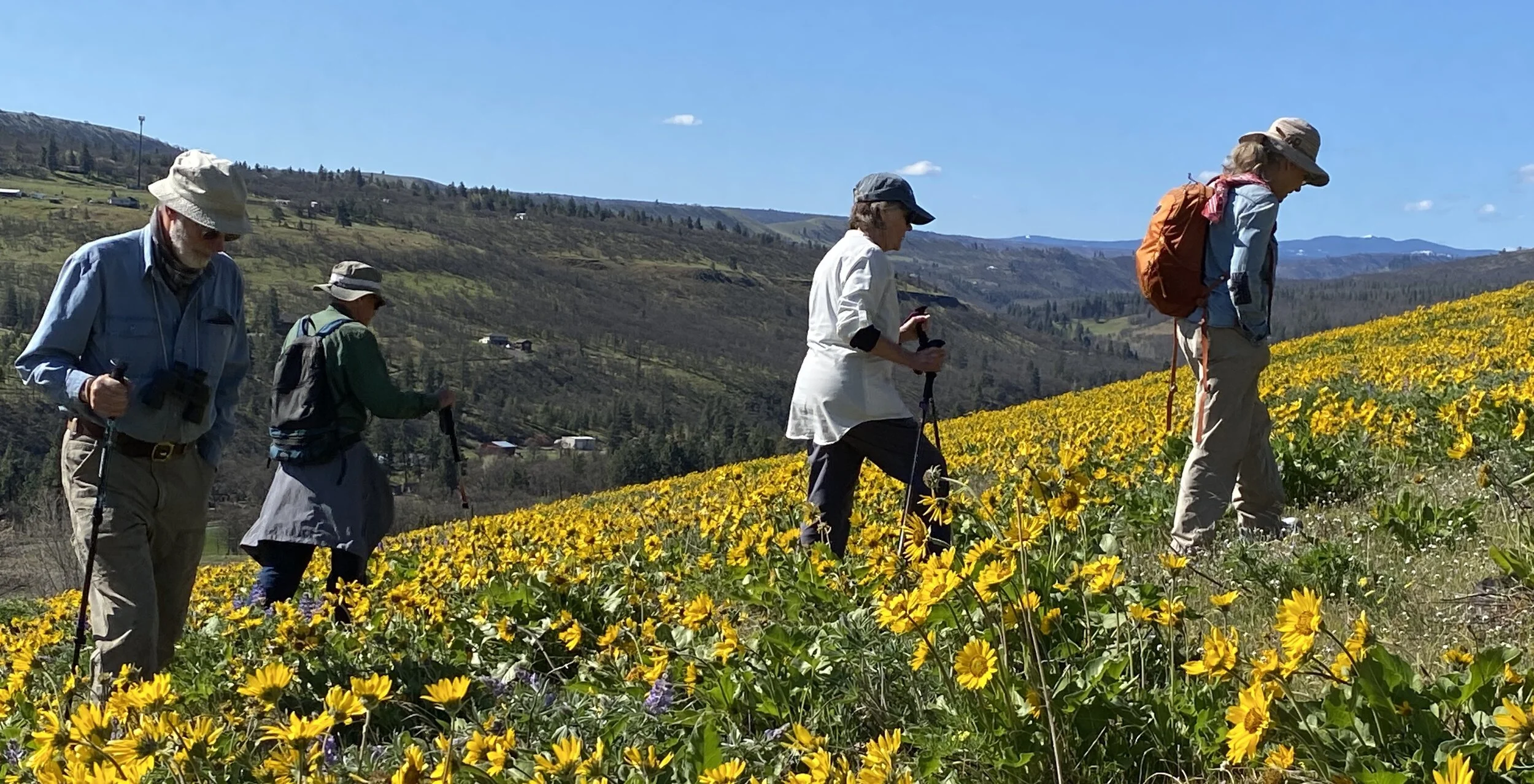Bears, Cougars, Snakes add to adventure; Don't be scared, be informed
Snake in the Grass - Can you spot the rattlesnake? Do you notice how zoomed in and out of focus this photo is? Remember to give animals their space!
By Erin Peters
“Be careful! There’s a rattlesnake up ahead!”
Have you ever heard this warning from a fellow hiker or mountain biker while enjoying a trail?
If you’re anything like me, these are NOT comforting words to hear while appreciating a sunny day in the gorge.
“What do we do?” “Do we turn around?” “What happens if it bites me?” These are all valid questions to ask yourself, but if you are on a trail, you need to know the answers!
But also know that the vast majority of encounters end up with humans and animals parting ways a bit shaken but uninjured.
Bear and Cougar attacks are quite rare and Rattlesnake bites while serious, are also very rarely fatal.
More likely than not encounters with wild animals add to the adventure. However, it’s good to have a little information in your pocket when this occurs.
Also know that insect or bee stings are a far more common problem. They can cause anaphylactic shock, causing swelling of the tongue and blocking airways. Those with allergies should carry an EpiPen or a good antihistamine such as Benadryl.
Our four-legged friends can also have the same response to stings or Rattlesnake bite. Benadryl can help them too until you can get them to a veterinarian. As a park ranger, I knew several dogs that lived to bark about a rattlesnake bite after some Benadryl and a few days at the vet’s office.
The standard dosage for oral Benadryl for dogs is 1 mg per pound of body weight, given 2-3 times a day. Most diphenhydramine tablets are 25 mg, which is the size used for a 25-pound dog, according to petmd.com - Tom Peterson
Let’s take a look at the Gorge’s top 3 animals that you need to be most aware of while out on the trail.
Rattlesnake Encounters
Whether you are walking along a trail and hear a rattling sound, or if you are riding your bike and suddenly notice a snake near you, it can be a frightening experience! Here in the Gorge, we have lots of trails at lower elevations that feature rattlesnakes in the spring through early fall.
There are a few things you need to remember if you come across a rattlesnake:
Do not make any sudden movements
Give the snake lots of room
Do not throw rocks or sticks at the snake
Keep your dogs and kids close by
The rattlesnake will not always rattle before it strikes
Rattlesnakes are most active in the morning and from dusk into the evening. It is important to be even more cautious at these times.
Rattlesnakes aren’t the only venomous reptiles on the trail! This ringneck snake has venom in its saliva that it uses to subdue its prey. They are completely harmless to humans.
Ways to stay safe from rattlesnakes on trails:
Wear long pants and tall socks for extra protection
Bring trekking poles to clear away brush that stretches over the trail
Find popular trails- snakes will avoid heavily trafficked areas
Avoid thick brush where snakes might be resting
It is important to remember that most rattlesnake bites are on the hands or fingers after people try to pick up or handle the animal, which is extremely unsafe and not smart. Snakebites are rarely fatal but can cause severe allergic reactions and infections. Each year there are between 7,000 and 8,000 cases in the United States where people have been bit by a venomous snake, and on average only 5 people die per year - that’s one in 65 million. Pretty good chance you’ll be ok.
What to do if a rattlesnake bites you:
Remain calm- increased heart rate will cause the venom to travel faster
Wash the wound with soap and water
Get medical help as soon as possible
Remove any items that could restrict swelling- snakebites should swell
Do not elevate the bite above your heart because the venom will spread to your heart faster
Do not cut the wound or attempt to draw out the venom in any way
Do not apply pressure or create a tourniquet
Do not elevate the wound
No ice
Bullsnakes look very similar to rattlesnakes, but they are not venomous. You might not be able to tell right away if the snake you have encountered is a rattle or bullsnake. Best practice is to be aware of your surroundings and give any animal lots of space.
Remember, snakebites are rare, and mostly happen when people are making poor decisions. Being prepared and knowing how to prevent a snake encounter is important for anytime you go outdoors.
Cougar Sightings
Encounter a Cougar? Back away slowly and do not run. Cougar attacks on people are extremely rare. There has been one known attack by a wild cougar in Oregon, which was fatal.
Cougars, also known as mountain lions, can be found in many parts of Oregon. While encountering a cougar in the woods seems like a terrifying experience, there are ways to exercise caution and helpful tips to make sure that if you do come across one of these beautiful animals, that you are well prepared.
When you are out in the woods, make sure that you are making noise. Cougars are secretive and do not want anything to do with humans. They hunt during dawn and dusk, so if you are out during those times your chances of seeing one are higher. Cougars mostly keep to themselves, but it is possible to come across one if you’re in the right place at the right time.
A general safety rule is to never hike alone. Being with other people on trails will decrease the risk of a cougar interaction greatly. If you have dogs or small children, do not let them wander off. Cougars are often drawn to smaller animals that they know they could beat in a fight easily.
If you see a cougar you should:
Back away slowly and do not run. Cougars are very fast and they might take your running as a challenge to chase.
Do not crouch or bend over. You will appear more like a cougar’s prey if you seem to have four legs rather than two.
Get BIG. Appear larger than you are by standing near your other hikers or bikers, raise your jacket and arms overhead, keep children and dogs close.
Yell with a firm voice. You want the cougar to know that you are not its prey and that you could be a danger to it.
Throw rocks, sticks, or branches if you can without bending down or turning around to try to scare it away.
If it attacks, fight back aggressively. Try to stay standing and protect your head and neck.
Cougar attacks are extremely rare, but are more likely if you are by yourself and not paying attention. Along with most other animals, cougars will protect their young. If you see cubs in the wilderness, there is probably a mama nearby. Stay alert, be aware of your surroundings, and report cougar sightings to a park ranger immediately.
Source ODFW
Source ODFW
Black Bear Country
While the black bear population in Oregon is between 25,000 and 30,000, human-bear incidents are rare in the state, according to officials. There have only been four previously reported incidents in the state since 1988, none of them fatal, ODFW said. Statistics have irrefutably shown that black bear attacks are extremely rare, and there has only ever been one fatal black bear attack in Washington State. That occurred over 40 years ago.
As with all other wild animals, black bears are very majestic, but also can be dangerous. Their behavior is often unpredictable. You never want to surprise a bear when you are out in the woods. For this reason, again, hiking with another person or a group will help you be a lot safer. While you are in the woods, have conversations with the people around you or attach something to your backpack that makes some noise. This gives wild animals time to hear you coming and leave the area.
We have black bears here in the Columbia River Gorge, and you should be prepared and know what to do if you encounter one.
Speak calmly with no sudden movements. Wave your arms slowly so the bear can identify you as a human, not a threat.
If a bear stands on its hind legs, don’t panic. They are often trying to get a scent and figure out who or what you are.
Stay calm. Bears do not want to attack humans. If you scream or make sudden movements, it may trigger an attack.
Pick up small children and dogs.
Back away slowly. No sudden movements. Do not try to climb trees because bears are excellent climbers.
Black bear attacks are extremely rare but fight back if one does attack. Carry bear spray to defensively stop a charging bear. Do NOT play dead with a black bear.
Be extra cautious if you see bear cubs.
Bear spray is environmentally friendly and will not permanently hurt the bear; it will create some distance between the two of you. Make sure the bear spray is easily accessible so you don’t have to dig through your pack to find it.
If you are camping, hang your food in a bag out of reach from the bear. There are also odor-protective containers you can use, so the bear won’t be drawn to your spot. The main goal is to cut down on the smell of food. Wash your dishes and utensils after you use them, and change your clothes after you’re done cooking. It is also wise to keep a flashlight in your tent along with some bear spray. The flashlight may scare the bear away if it gets too close.
Remember, it is YOU that is the visitor here. You are in these wild animals’ homes and you need to respect their space. Always travel in groups, be prepared, and never sneak up on a wild animal. Following these tips and tricks should help you feel more confident while on trails or in the woods.














